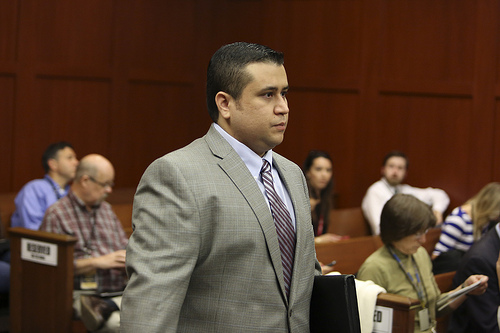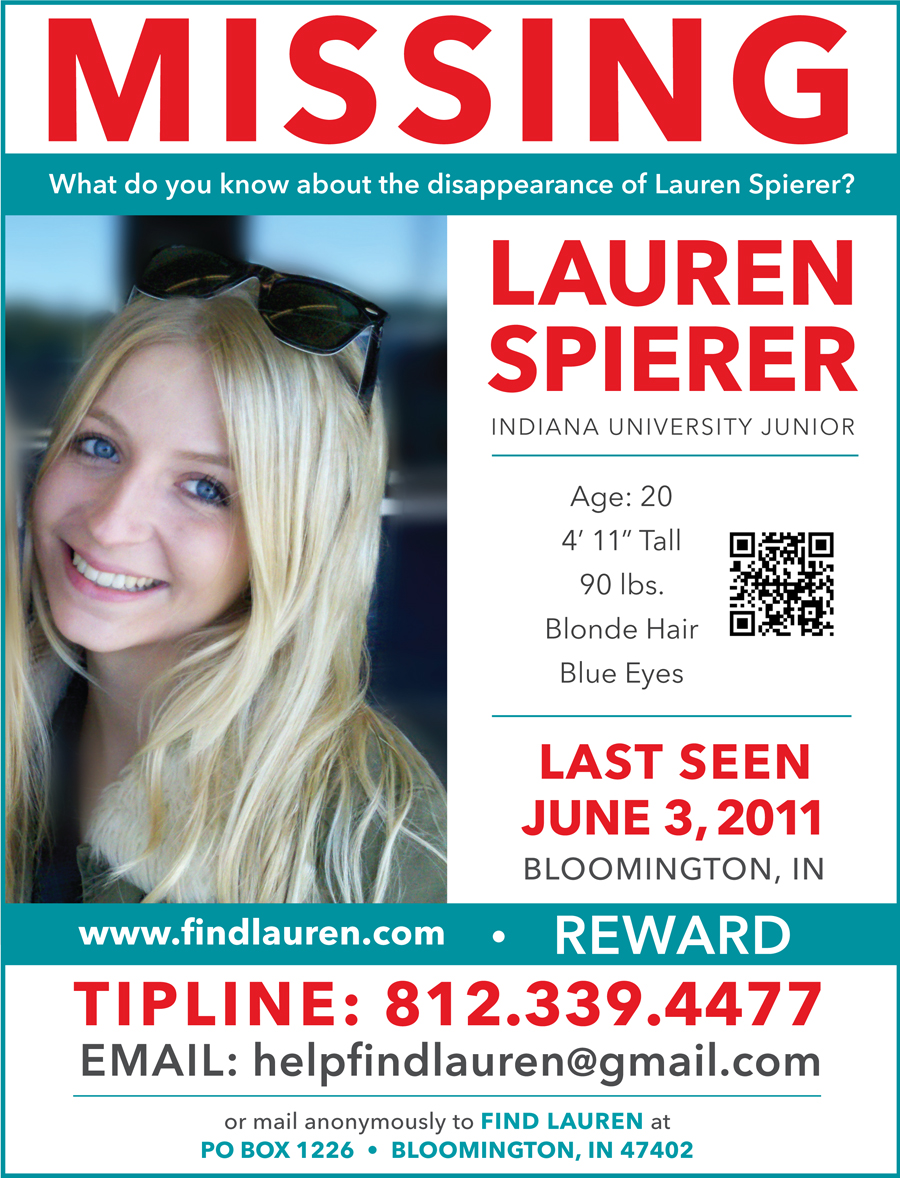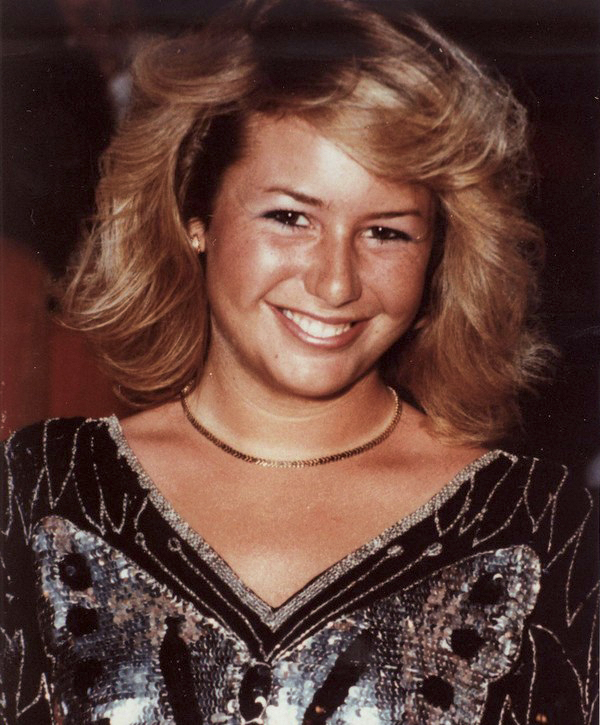Voir Dire Straits
 Saturday, June 15, 2013 at 7:35PM
Saturday, June 15, 2013 at 7:35PM  George Zimmerman enters the court room on the fifth day of jury selection for his trial in Seminole circuit court in Sanford, Fla., Friday June 14, 2013. Zimmerman has been charged with second-degree murder for the 2012 shooting death of Trayvon Martin. (Gary W. Green/Orlando Sentinel, Pool)
George Zimmerman enters the court room on the fifth day of jury selection for his trial in Seminole circuit court in Sanford, Fla., Friday June 14, 2013. Zimmerman has been charged with second-degree murder for the 2012 shooting death of Trayvon Martin. (Gary W. Green/Orlando Sentinel, Pool)
A lot could be said about the first week of jury selection in the George Zimmerman trial, but I will spare you most of the somewhat boring and quite tedious details. I must tell you that it’s an intense study into the human psyche. Some of those interviewed seemed to beg for the chance to sit on the jury; as if to say (quietly) OUT LOUD that there could be a book deal down the road. At least, that’s the perception made by some of my media peers.
There’s also the matter over knowledge of the case. No one in Sanford, let alone all of Central Florida, is expected to be mentally blind to the tragic shooting death of Trayvon Martin by George Zimmerman. To deny knowing anything about it is to be so out of tune with current events, it’s close to incompetency. Or it’s a giant lie — obviously knowing more than one would admit to. Either way, this is the type of pre-trial publicity questioning that should qualify or disqualify a prospective juror. It’s like sifting through the weeds of a garden to get to the root vegetables; like carrots hidden under a lush layer of rich soil, waiting to be plucked and added to the recipe now simmering inside the Seminole County Courthouse.
When making a good stew, one must be very careful about the ingredients added. Too much salt is not good. Neither is too much pepper…. which leads me to a working segue — one of the potential jury prospects — E-7, a white male in his 50s with salt & pepper hair and a goatee. Soon after questioning began, I turned to the person to my left, a woman from ABC network news, and whispered that I recognized him from somewhere; like we had met or something. I couldn’t place him then and still can’t.
Initially, I thought he was quite smart and open. He seemed pretty square and strong in his tenets. I noticed he was a bit adversarial while facing Bernie de la Rionda, but he said he liked playing the role of devil’s advocate. OK, fine, but when Don West questioned him, I began to feel a bit leery and said so in my notations. I wrote that he was a bit cocky and sure of himself. Something about his earnest sincerity began to unravel. Here’s a guy who stated that he watches both FOX and MSNBC. Open minded? At first glance, yes, it appeared that way, yet he paid no attention to either side. That didn’t compute in my head. He was someone, I wrote, who says he knows nothing, but he “knows too much, perhaps. Or a know it all.”
The final thing I wrote was “I don’t think so,” meaning, he will not sit on the jury.
When he left the courtroom after questioning, I was surprised when the judge called him back to ask about a comment made on Facebook. Did he write it? No need to explain why. Just say yes or no. He admitted to it and I knew right then and there he was doomed. This man, Jerry Patrick Counelis, is a pathetic human being. Sick. Everyone from both sides wants this to be a fair trial. Counelis tried to infiltrate the jury; to force his pro-Martin agenda on everyone else. Had he been selected, it would have been a terrible blow to justice.
Two days later, Counelis returned to the courthouse to express his concern over the lack of anonymity and privacy during the selection process. Huh? He was only happy to be questioned publicly Wednesday after leaving the courthouse. He gladly appeared on local and national television later that day and night and he has concern over WHAT? When I stopped for coffee at my local 7-Eleven on Thursday morning, an employee told me he was interviewed right in the parking only the day before. Because he protested loudly at the courthouse on Friday, kicking and screaming and attempting to get back to the jury room, he was trespassed until the end of the trial. In my opinion, a trespass was not enough. Instead, the man should have been arrested on the spot and held without bond until the end of the trial; then tried in criminal court. On what charges? Whatever could legally be thrown at him. He is the epitome of social immorality. Thankfully, he was caught by someone from the defense side and was stopped dead in his tracks. Imagine the dire consequences…
On Thursday, E-81 took center stage. She was an attractive woman who told de la Rionda that she thought Zimmerman was innocent. One of the first things that caught my mind was a simple statement that came out of her mouth. Trayvon Martin wasn’t beat up like George Zimmerman. He was dressed like a street fighter. Duh… he only had a bullet in his heart.
She made up things as she went along. Zimmerman had blood on his clothing. Down his collar and on shirt. Trayvon was a pot smoker. Guns. Street fighting. Parents weren’t aware he was going down the wrong path. George was just doing his job at neighborhood watch. Drugs made Trayvon aggressive. George was protecting his neighborhood.
She told de la Rionda she wouldn’t be able to erase it from her mind, which was pretty well made up. She told him she was quite educated. I laughed under my breath. Every American has a right to protect themselves. The more armed people; the better. She admitted she wanted to donate money to the Zimmerman defense, but didn’t.
When O’Mara took over the questioning, she mellowed to a good extent. Where she had been more adversarial to de la Rionda, she was amenable to the cordial defense attorney. When prompted, she said she could follow evidence and court instructions. If Martin’s alleged street fighting is “not presented at trial, she would not consider it,” she added. She said she had “no real concerns about leaving opinions out of the equation,” I didn’t believe her one bit and made note of it.
Baloney! She sways in the breeze, but is fervent in her beliefs. I am convinced of it.
She was summarily dismissed later on.
This leads me to a very interesting and important part of jury selection. How many strikes does each side get? When we broke for lunch that day, someone sitting on the public side addressed the possibility that the defense was forcing the state to use one of their strikes on E-81. After all, she seemed to be more neutral by the time O’Mara was finished questioning her, but was she, and did it really matter? A local legal analyst said that the Defense had the State on the run, but was it true? Or was it merely another opinion formed by a criminal defense attorney turned temporary legal analyst?
In the state of Florida, one of the frequent questions concerns challenges from each side. This is directly from an e-mail sent out from the Court Services Administrator/PIO to all credentialed journalists:
Q. How many challenges does each side have in jury selection?
A. Because this charge is punishable by life in prison, each side will have 10 peremptory challenges and unlimited challenges for cause. Challenges are also commonly referred to as strikes.
Law.com describes peremptory as:
[T]he right of the plaintiff and the defendant in a jury trial to have a juror dismissed before trial without stating a reason. This challenge is distinguished from a “challenge for cause” (reason) based on the potential juror admitting bias, acquaintanceship with one of the parties or their attorney, personal knowledge about the facts, or some other basis for believing he/she might not be impartial. The number of peremptory challenges for each side will differ based on state law, the number of parties to a case, and whether it is a civil or criminal trial. The usual phrasing used by lawyers exercising the challenge is “Juror number seven may be excused.”
§
While I’m on a legal roll, let me continue by explaining why there are six jurors on this case:
Florida Statute 913.10
Number of jurors. — Twelve persons shall constitute a jury to try all capital cases, and six persons shall constitute a jury to try all other criminal cases. History.—s. 191, ch. 19554, 1939; CGL 1940 Supp. 8663(198); s. 87, ch. 70-339.
The Sixth Amendment to the U.S. Constitution states:
In all criminal prosecutions, the accused shall enjoy the right to a speedy and public trial, by an impartial jury of the state and district wherein the crime shall have been committed, which district shall have been previously ascertained by law, and to be informed of the nature and cause of the accusation; to be confronted with the witnesses against him; to have compulsory process for obtaining witnesses in his favor, and to have the assistance of counsel for his defense.
In an 1898 ruling, the Court wrote, “a jury comprised of 12 persons, neither more or less” was a requirement. If that’s the law of the land, then what happened? Why six? In Williams v. Florida, 399 U.S. 78 (1970), the Court reconsidered the size of a jury and affirmed the criminal robbery conviction made by six people. The Court ruled that the Sixth Amendment says nothing about jury size. From hence on, it rejected the earlier decision and held that six was sufficient to satisfy the Sixth and Fourteenth Amendments, which, in part, states that:
[…] No state shall make or enforce any law which shall abridge the privileges or immunities of citizens of the United States; nor shall any state deprive any person of life, liberty, or property, without due process of law; nor deny to any person within its jurisdiction the equal protection of the laws.
In 1979, the Court again visited the issue of jury size and unanimity. In Burch v. Louisiana, 441 U.S. 130 (1979), they found that Louisiana law which allowed criminal convictions on 5-1 votes by a six-person jury had violated the Sixth Amendment (along with the Fourteenth Amendment) right of defendants to a trial by jury. In a state criminal trial:
We thus have held that the Constitution permits juries of less than 12 members, but that it requires at least 6. And we have approved the use of certain nonunanimous verdicts in cases involving 12-person juries… This case lies at the intersection of our decisions concerning jury size and unanimity… But having already departed from the strictly historical requirements of jury trial, it is inevitable that lines must be drawn somewhere if the substance of the jury trial right is to be preserved.
In other words, if a jury is to be as small as six, the verdict must be unanimous. Therefore, in Zimmerman’s case, a guilty verdict can only be rendered unanimously or not a all.
§
I will have more to write about this case as the trial progresses. This coming week should prove to be much more exciting than the first one, although I do find the whole thing to be quite fascinating and educational.
There are questions I am asked during this tedious process I sometimes have trouble answering. One, for example, is about George Zimmerman. What does he look like in court? What are his expressions? I can tell you this. I sit behind the Defense. All journalists do. I cannot see George’s face unless he turns sideways. I occasionally put the live feed on one of my iPads, but it’s a battery drainer; however, I do have my spy, code name Pea Pod, who keeps me informed while I stare at the back of Zimmerman’s head. For those of you who cannot watch the trial, he is more animated now than he was during the hearings. He must be! Potential jurors are watching. He is taking notes and smiling. He is paying close attention to details. This is very normal. Jodi Arias was transformed into a librarian by her attorneys. During the Casey Anthony trial, her seat was adjusted to its lowest elevation so she would appear to be too tiny to have murdered her child. Poor, poor, Casey; sitting next to Cheney Mason, who was much, much larger. He put his arms around her to comfort her; squeezing her shoulder. He patted her hands as they rested on the table. Pity, pity, pity party.
In Zimmerman’s case, he pretty much has to fend for himself, whether you like him or not. He weighs over 100 lbs more than the day he shot Trayvon. The jury must be made aware of that. While he most certainly will never be a demure librarian, he will never be a cop or judge, either — something he aspired to be — no matter what the verdict.
And Trayvon? Whatever some of you may think, he was not a 6’3” monster weighing over 180 lbs, and the jury isn’t going to hear that he was.
See also: Daily Kos
 Dave Knechel | tagged
Dave Knechel | tagged  Jury,
Jury,  Voir Dire | in
Voir Dire | in  Bernie De la Rionda,
Bernie De la Rionda,  Casey Anthony,
Casey Anthony,  Cheney Mason,
Cheney Mason,  Dave Knechel,
Dave Knechel,  David B. Knechel,
David B. Knechel,  David Knechel,
David Knechel,  Donald West,
Donald West,  Eighteenth Circuit Court,
Eighteenth Circuit Court,  FOX News,
FOX News,  George Zimmerman,
George Zimmerman,  Judge Debra S. Nelson,
Judge Debra S. Nelson,  MSNBC,
MSNBC,  Marinade Dave,
Marinade Dave,  Marinade Dave Knechel,
Marinade Dave Knechel,  Mark O'Mara,
Mark O'Mara,  Neighborhood Watch,
Neighborhood Watch,  Seminole County,
Seminole County,  Seminole County Courthouse,
Seminole County Courthouse,  State Attorney Angela Corey,
State Attorney Angela Corey,  Trayvon Martin,
Trayvon Martin,  marinadedave |
marinadedave | 












 LEGAL NOTICE
©David B. Knechel. All Rights Reserved. No portion of this site can be reproduced in it's entirety or in part without expressed written permission by the owner/administrator of this site in accordance with the Digital Millennium Copyright Act. Section 512(c)(3) of the U.S. Copyright Act, 17 U.S.C. §512(c)(3). The charges against defendants are mere accusations and the subjects are presumed innocent until found guilty in a court of law.
LEGAL NOTICE
©David B. Knechel. All Rights Reserved. No portion of this site can be reproduced in it's entirety or in part without expressed written permission by the owner/administrator of this site in accordance with the Digital Millennium Copyright Act. Section 512(c)(3) of the U.S. Copyright Act, 17 U.S.C. §512(c)(3). The charges against defendants are mere accusations and the subjects are presumed innocent until found guilty in a court of law.